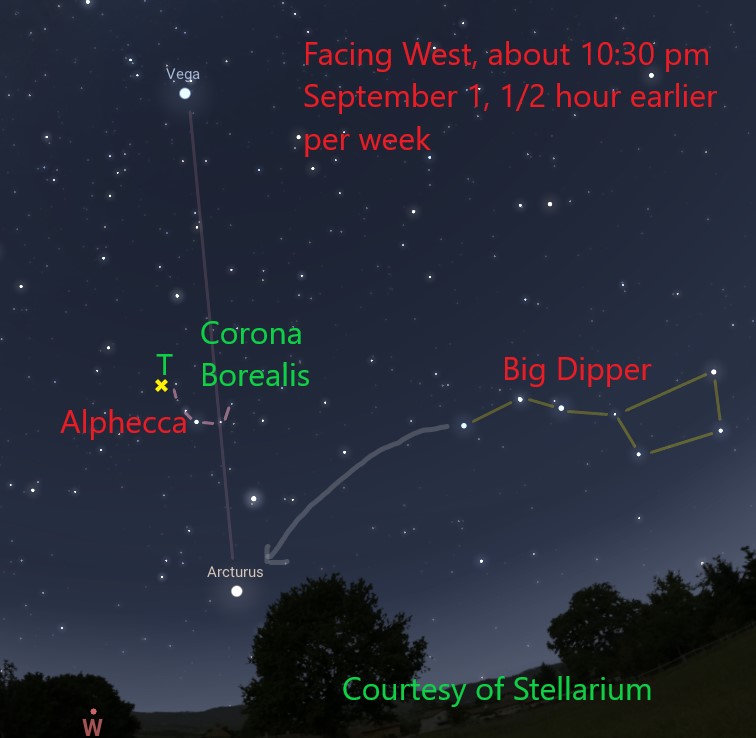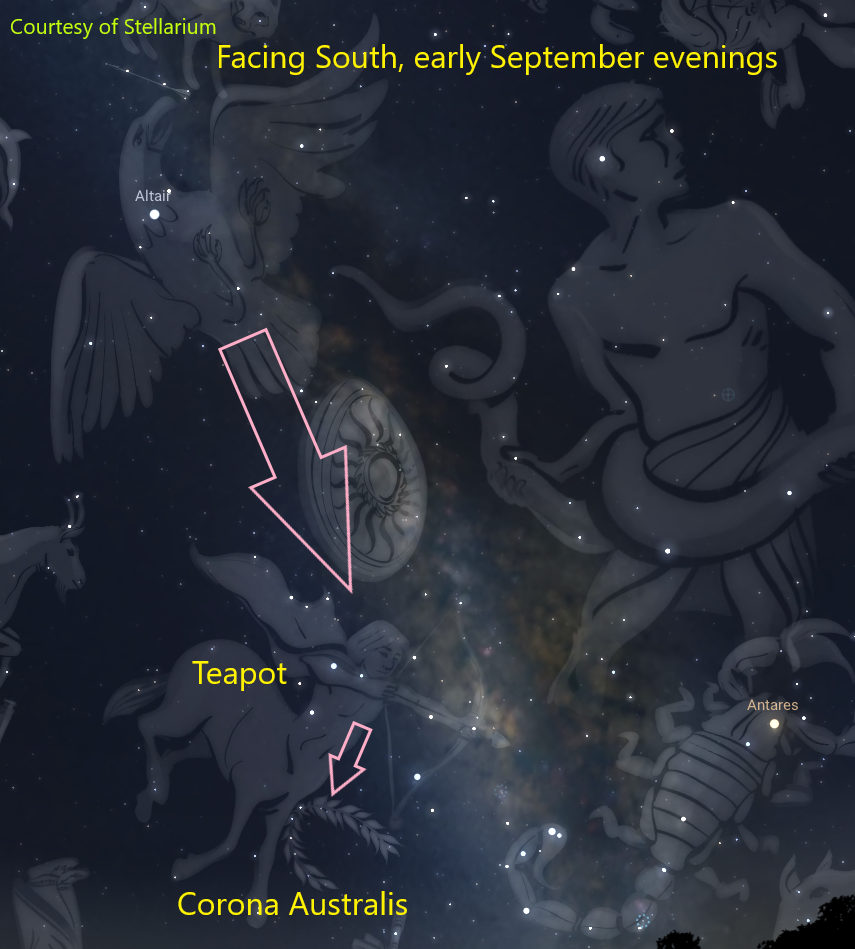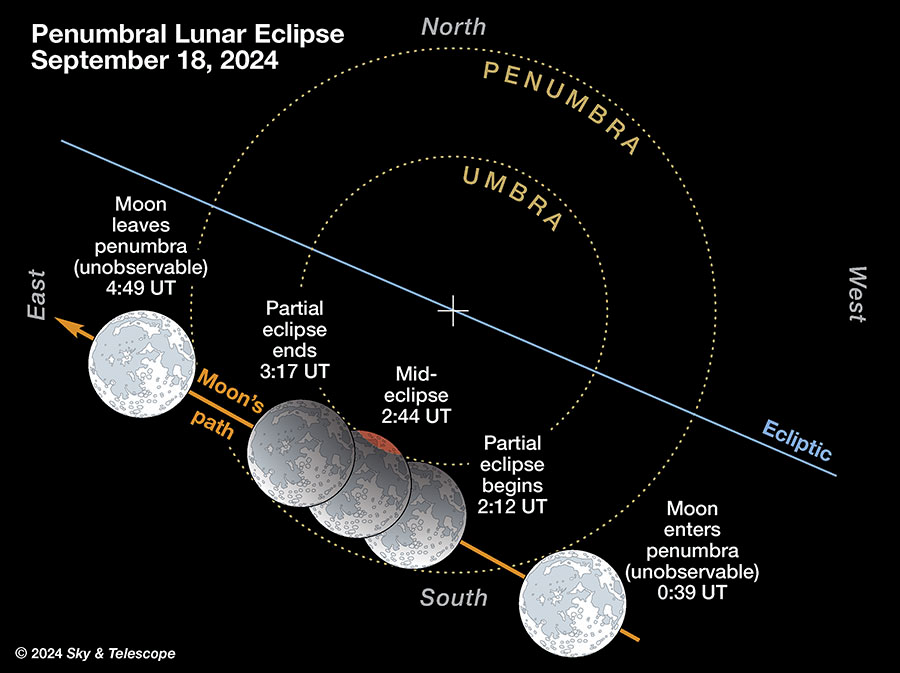CROWNING GLORY??
I don’t think I have ever discussed a small but graceful constellation currently visible in the evening skies- Corona Borealis, also known as the Northern Crown. To see it, you will want to find a spot with a fairly open view to the west, and you will want to bring binoculars with you if you have a lot of light pollution at your viewing location. Start with the Big Dipper, easily found in the northwestern sky. Follow the arc of the Big Dipper’s handle to the bright star Arcturus, rather low at the time of our map below. Very high in the western sky is Vega, which will probably look a bit brighter than Arcturus. Look closely just about 1/3 of the way from Arcturus to Vega for a somewhat dimmer star, called Alphecca. As the chart shows, Alphecca is the brightest member of a graceful curving group of stars that form the Northern Crown. I can see most of these stars on a very good night from my home about 20 miles from downtown St. Louis, but binoculars make them much more distinct and are essential if there is any sort of moonlight or haze in the sky.
Although small in size and not very bright, the Northern Crown is one of the 48 constellations that was catalogued by Ptolemy in the second century and figured prominently in the mythology of several cultures. The Iroquois saw it as a porcupine, while to the ancient Greeks, the crown was worn by Ariadne, daughter of King Minos of Crete. She saved the day when her father was forced to condemn fourteen youths and maidens to the not-so-tender mercies of the fearsome Minotaur, who was half human, half bull. The Minotaur’s lair was at the center of the Labyrinth, an exceedingly complicated maze. Ariadne gave the hero Theseus a ball of thread which he used to navigate his way through the maze and finally slay the monster. Of course, the two fell madly in love, but not for long as Theseus soon abandoned her on the island of Naxos. Finally, Dionysus, the God of wine-making, vegetation, and various sources of entertainment spied Ariadne sleeping and carried her off to be his wife, throwing her crown into the sky to form Corona Borealis.
The Northern Crown might soon be the scene of a very rare sky event. The star indicated as “T” on the map is normally tenth magnitude, or too faint even for ordinary binoculars. However, in 1866 and 1946, the star very suddenly brightened about a thousandfold over a period of mere hours, a phenomenon called a recurring nova. Scientists have found that the system consists of a very dense white dwarf star (believed to be the future fate of the Sun), closely paired with a much less dense cool red star. The white dwarf’s more powerful gravity gradually accumulates material from the red star, and then this eventually heats up and causes the massive eruption. Astronomers believe that T Corona Borealis is following past patterns and might erupt at almost any time within the next few months. If it does, it could become similar in brightness to Alphecca, or fairly bright to the naked eye. I have been trying to watch for it whenever I can, and it really takes little effort. You can try it yourself- maybe you will be one of the first to see it! If and when T Cor Bor does erupt, I am sure it will get a lot of attention on social media.

Corona Borealis is located about one third of the way from the bright star Arcturus to similarly bright Vega.
If you had fun finding the Northern Crown, it has a much more challenging and dimmer counterpart in the southern sky, Corona Australis. The Southern Crown is really too far south to be easily seen from our latitude unless you use binoculars. If you want to try it, notice that Vega in the west is actually one of the members of the huge Summer Triangle of stars, including Deneb nearly straight up at this time of year, and Altair, the brightest star in the south. I have written about the Summer Triangle in this space several times, most extensively in the September 2021 edition. From a location dark enough or with the help of binoculars, you can trace out the stars of Sagittarius, to the lower right of Altair. The brightest stars in the upper body and bow of the archer in the illustration form a recognizable teapot pattern that is much easier to figure out. If you can easily spot the teapot stars from your location, at least with binoculars, can you make out any of the dim stars of Corona Australis below, close to the southern horizon? The map also shows the Milky Way, whose center is in this direction of the sky. To see that well, you would have to go to an extremely dark location on an extremely clear night.

The Southern Crown is a challenging find from mid northern latitudes
One final note- September’s Full Moon is often called the “Harvest Moon” as its light shines brightly after sunset, allowing farmers to work on bringing in their crops. This year, the Harvest Moon, occurring the night of September 17th, has two added benefits- the first being that it will be 7% closer to the Earth than average. Some call these events “Supermoons” but to be honest the effect is only slightly noticeable to the naked eye. Second, the Moon will also briefly dip into Earth’s umbral shadow that night, causing a minor Partial Lunar Eclipse. Many people know that a total eclipse of the Moon usually turns the lunar disk an eerie coppery color, sometimes called the “Blood Moon.” Unfortunately, just 8.5% of the Moon will be covered in shadow at maximum at 9:44 pm on the night of the 17th. The upper edge of the Moon should be noticeably dark around that time, weather permitting. Although not a huge event, I do plan to be watching.
 The Moon dips into Earth’s shadow on the night of September 17th. Note that zero hours Universal Time on the 18th is 7 pm Central Daylight time on the 17th. Courtesy of Sky & Telescope magazine.
The Moon dips into Earth’s shadow on the night of September 17th. Note that zero hours Universal Time on the 18th is 7 pm Central Daylight time on the 17th. Courtesy of Sky & Telescope magazine.Did you enjoy reading about the stories of the Northern Crown? You might enjoy our next Gateway to the Stars program, “Legends of the Fall Sky,” scheduled for Friday evening, September 13 at 6:30 pm. The program will be held outdoors on the Entrance Plaza, but could be moved inside the Main Entrance in the event of inclement weather. If skies are at least partly cloudy, telescope viewing will take place on the Plaza until 8:30 pm, with views of the Moon and Saturn available. Call 314-655-1704 the afternoon of the 13th to check on the status of the weather if you’re not sure.
